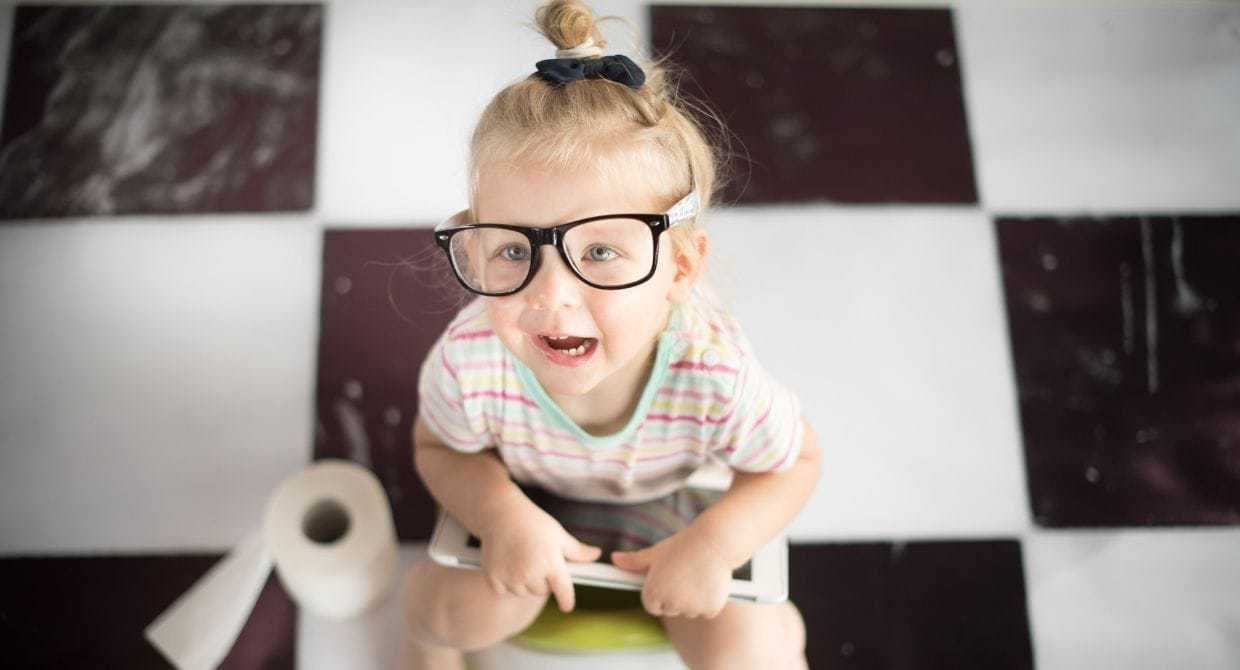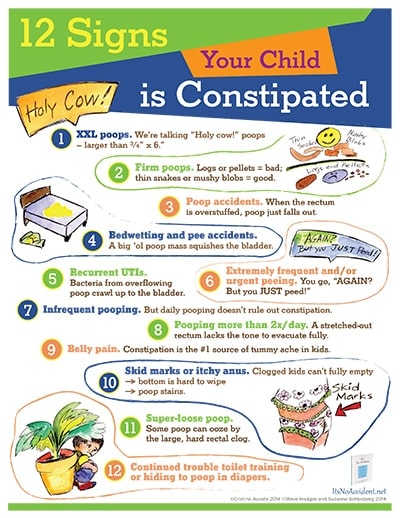What Every Parent Should Know About Bedwetting, Accidents, and Potty Training
A guest post by Steve Hodges, M.D.
As far as I know, no mom has ever tweeted:
Wet sheets again for Kyle. Whole family is exhausted. #WishBedwettingWouldStop
Toileting problems aren’t openly discussed in our culture. But in my pediatric urology clinic, they’re what I talk about all day long — with distressed parents and with kids who miss out on sleepovers and feel crummy that they can’t stay dry.
Most of these families have been led to believe that:
a) accidents and bedwetting are a normal part of childhood, and
b) they need to wait it out.
Both notions are wrong. Truly, most of what parents and even many pediatricians believe about toileting troubles is not based in fact.
Here’s the real poop…
MYTH #1
Kids wet the bed because they’re deep sleepers or their “bladder hasn’t caught up to their brain” or for psychological,
hormonal, or hereditary reasons.
Reality: Most children wet the bed because their rectums are clogged with poop.
The hard, bulging poop mass presses against the bladder, compromising its capacity and irritating the nerves feeding it.
Bedwetting is not caused by deep sleep (here’s why), an underdeveloped bladder, hormones, or stress and is never, ever a child’s fault.
And while bedwetting can run in families, it’s the propensity toward constipation, not the bedwetting itself, that’s passed down.
The constipation-bedwetting link is well documented in the scientific literature and is confirmed daily in my practice. Problem
is, many doctors rely on inadequate methods of detecting constipation (they ask how often the child poops and press on the child’s abdomen). Other doctors don’t know, or don’t believe, that constipation is by far the leading cause of bedwetting.
Let’s talk evidence…
The most rigorous studies ever conducted on childhood wetting were led by Sean O’Regan, a kidney specialist drawn to the topic because his 5-year-old son wet the bed every night. A test called anorectal manometry showed his son’s rectum was so stretched by stool that the boy couldn’t detect a tangerine-sized air balloon inflated in his bottom. His rectum had lost the tone necessary to fully evacuate and the ability to sense the urge to poop. So, stool would just pile up.
Ultimately, O’Regan’s Canadian research team tested hundreds of children with enuresis (daytime and nighttime pee accidents) and encopresis (poop accidents). Virtually all were, like O’Regan’s son, stuffed with poop.
When their rectums were cleaned out with daily enemas, the wetting and soiling stopped.
In my clinic, we X-ray every child who presents with toileting problems (X-rays are easier to conduct and to undergo, than anorectal manometry) and measure the diameter of their rectums. A normal rectum is no wider than 3 cm.
Well over 90% of my wetting patients are shown to be extremely constipated, with rectums stretched far beyond normal. In our bedwetting study published in Global Pediatric Health , all the bedwetting patients had rectal diameter greater than 6 cm.
Like O’Regan’s patients back in the eighties, mine stop wetting once their rectums are clear and shrink back to normal size.
Yes, even the “deep sleepers” and the kids with “small bladders” or family history of bedwetting.
If your doctor attributes your child’s bedwetting or daytime accidents to any cause other than constipation, I would insist on an X-ray and measurement of rectal diameter.
MYTH #2
Your child will “outgrow” bedwetting and accidents if you wait it out.
Reality: Many children do outgrow wetting; some come to my clinic as distressed 10th graders. Do you want to find out which category your child will fall into?
Many pediatricians won’t show the slightest concern about bedwetting until a child is at least 7 — and even then, many won’t take action. But research shows this is unwise — especially if a child wets the bed nightly and/or has daytime accidents.
In a study of more than 16,000 children, researchers concluded that the notion that bedwetting will spontaneously resolve with age “probably applies only to those with mild enuretic symptoms” — in other words, kids who wet the bed infrequently.
Children with daily symptoms are far likelier to become bedwetting adults. In fact, left untreated, a 9-year-old who wets the bed has about a 70% chance of becoming a 19-year-old who wets the bed.
My opinion: If your child is 4 or older and wetting the bed, especially if the child shows any of the red flags listed in our 12 Signs Your Child is Constipated chart, insist on an X-ray and aggressive treatment, discussed in myth #5.
Like bedwetting, daytime pee and poop accidents are not normal in toilet-trained children and are caused by holding stool. Sure, during the potty-training process kids will have accidents. But children who never quite graduate to fully toilet trained are not late bloomers; they’re constipated.
MYTH #3
When children have trouble toilet training, it’s because their parents started the process too late.
Reality: It’s the children who train earliest who typically end up, a couple years later, with the most severe problems. Yes, this applies to those potty-training prodigies who “trained themselves” at 18 months!
Research at my clinic, published in Research and Reports in Urology, found that children who trained before age 2 had triple the risk of developing daytime wetting problems compared to children who trained between 2 and 3. The early trainers also had triple the risk of becoming constipated.
This isn’t to say I recommend potty training 26-month-olds. I don’t. Based on my experience, I don’t think children under 3 should be in charge of their own toileting habits any more than they should be in charge of the family budget. Sure, toddlers can be trained to use the toilet; that doesn’t mean they will respond to their bodies’ urges in a timely manner. Young children are more prone to holding.
I know many parents are under pressure to meet preschool potty training deadlines. My take: find a different preschool. The
risks of early or rushed toilet training are too great.
So why do so many late potty trainers pee and poop in their pants? Because these kids were constipated when potty training
began and were therefore destined for failure.
MYTH #4
Kids who poop every day or have soft stools can’t be constipated.
Reality: Many chronically constipated kids poop daily, even multiple times a day, and many have loose stools.
How can that be? Well, a stretched-out rectum lacks the tone to evacuate fully, so many constipated kids need to poop often. And “fresh,” soft poop can ooze past a hard clog, so a constipated child may even appear to have diarrhea.
While it’s true that everyone who eats daily should poop daily, you can’t assume a child who poops every day is not constipated.
The “corn test” some doctors recommend — where your child eats corn and you note how long it takes for the bright yellow
kernels to show up in her stool — is worthless. Bowel transit time is just not a reliable indicator of constipation.
What does signal constipation in kids? Giant bowel movements are the reddest of red flags, as I explain to kids in Jane and the Giant Poop. Other signs: hard, formed poops that resemble rabbit pellets or logs; underwear “skid marks,” stomachache, chronic urinary tract infections, and, of course, accidents of any kind.
Many pediatricians fail to detect constipation because they follow the inadequate guidelines of the International Children’s Continence Society: They simply ask parents whether their children’s bowel movements are infrequent and if their stool consistency is hard.
MYTH #5
You can fix a child’s chronic constipation with a high-fiber diet and some Miralax.
Reality: No amount of prunes will dislodge a large, hard mass of poop clogging a child’s rectum. Nor will daily,
small doses of Miralax do the job. Only when you take aggressive measures will a chronically, severely stretched rectum bounce back to normal size and recover permanently.
The regimen I recommend, the Modified O’Regan Protocol (M.O.P.), combines enemas with oral laxatives, such as Miralax, magnesium citrate, or lactulose. (Yes, enemas are safe for constipated children.)
Whatever method you use, it’s important for the rectum to be cleaned out on a daily basis for several weeks. This will allow it to shrink back to size, regain tone and sensation, stop encroaching upon the bladder, and stop aggravating the nearby nerves. A one-time clean-out is unlikely to accomplish all that.
Withholding stool is a deeply ingrained habit in children, so when half-measures are taken, relapse rates are high.
I used to recommend, as a reasonable alternative to enemas, a high-dose Miralax clean-out followed by a maintenance regimen of the laxative. But I no longer do, because my published research, and my experience with more than 2,000 patients, have demonstrated that laxatives are not nearly as effective enemas for resolving bedwetting or daytime accidents.
In one study, published in Global Pediatric Health, my clinic found that after three months, 30% of the patients treated with Miralax had stopped wetting, compared to 85% of the patients treated with M.O.P.
Yes, enemas are safe. They do not cause dependence, electrolyte imbalance, or psychological trauma, as I explain in The Physician’s Guide to M.O.P., a free download you can hand to any skeptical doctor.
Of course a high-fiber diet is important, for preventing constipation and a recurrence. Every day I see patients whose junked-out diets are exacerbating their problems or compromising recovery. Our highly processed diet is a major contributing factor to our nation’s potty-problem epidemic. (Early toilet training is another.)
However, the first order of business has to be breaking up the clog.
Why hasn’t your pediatrician mentioned all this? The link between constipation and urinary problems isn’t typically taught in medical schools, at least not in depth.
I didn’t learn this stuff myself until well after I’d started practicing — and after I’d steered hundreds of patients wrong. At no point in my urology training did anyone mention Sean O’Regan’s studies.
A couple years back, I tracked down Dr. O’Regan, now retired and living in Arizona. I asked him why he thought his research, compelling as it was, never made a splash. He told me: “Constipation is a distasteful subject. No one wants to talk about it.”
That’s as true today as it was back in Dr. O’Regan’s era.
Steve Hodges, M.D., is a pediatric urologist, an associate professor at Wake Forest University, and the father of three girls.
His books include
Bedwetting and Accidents Aren’t Your Fault,
Jane and the Giant Poop, and
The M.O.P. Book: A Guide to the Only Proven Way to STOP Bedwetting and Accidents, all available on amazon or at
BedwettingAndAccidents.com.
What You Should Do Next:
1. Get Quick Actionable TIPS delivered to your inbox
Sign up for my newsletter for parenting tips to help you create a happier home and become the parent you always wanted to be. Plus, when you subscribe, I'll also send you a copy of our strategy-packed guide 10 Tips for Better Behavior – Starting NOW!
2. Unlock the secrets to easier parenting in my FREE CLASS
Register for my free class called How to Get Kids to Listen, Without Nagging, Yelling or Losing Control. Classes run several times per week to accommodate your busy schedule.
3. Transform your family with the 7-Step Parenting Success System® Course
Join the hundreds of thousands of parents who have transformed their families with the 7-Step Parenting Success System® Course. Learn the tools you need to raise happy, respectful, responsible kids and create the family life you always dreamed of having.
About the Author







